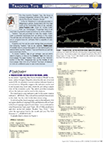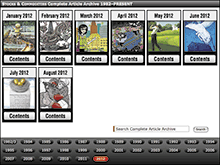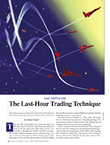LETTERS TO THE EDITOR
October 2012 Letters To The Editor
The editors of S&C invite readers to submit their opinions
and information on subjects relating to technical analysis and this magazine.
This column is our means of communication with our readers. Is there something
you would like to know more (or less) about? Tell us about it. Without a source
of new ideas and subjects coming from our readers, this magazine would not
exist.
Address your correspondence to: Editor, Stocks & Commodities,
4757 California Ave. SW, Seattle, WA 98116-4499, or E-mail to editor@traders.com.
All letters become the property of Technical Analysis, Inc. Letter-writers
must include their full name and address for verification. Letters may
be edited for length or clarity. The opinions expressed in this column do not
necessarily represent those of the magazine. —Editor
AUGUST 2012 TRADESTATION TRADERS’ TIP
 Editor,
Editor,
I have a question about TradeStation’s Traders’ Tip from the August 2012 S&C.
When I downloaded the EasyLanguage code file “SEMIND.ELD” from the TradeStation support forum website as mentioned in the writeup, the indicator feature could not be displayed on the chart. The error message I received was “_SRMIND is missing Data 2,3,4,5,6.” Please advise how I can solve this issue. Thanks very much.
Jia
Mark Mills, director of EasyLanguage Support at TradeStation Securities, replies:
The calculations performed by “_SRMind” require six symbols. Here are the six symbols:
- Data1 = Stock index
- Data2 = XLY
- Data3 = XLF
- Data4 = XLE
- Data5 = XLU
- Data6 = XLP
When TradeStation creates a chart, it automatically inserts a symbol. This symbol is “data1.” Data2 through data6 need to be manually inserted using the “Insert symbol” option:
By selecting “Insert → Symbol,” you will get the “Insert symbol” dialog:
Then type in the desired symbol and click “plot.” Once all six symbols are on the chart, the indicator will work properly.
In our Traders’ Tips writeup, we formatted each symbol such that it was “hidden” and not displayed on the chart. This was done by using the option “Format → Symbol → Scaling → Hidden” for data2 through data6.
Please contact us if you have further questions.
S&C ARTICLE ARCHIVE
Editor,
It would be helpful if you dated your articles in your archive, because when a search is made, there is no indication of the article’s date. Your search engine is not very helpful in finding info even when I know an article is in there somewhere!
Ian Harvey
 Articles are organized by volume and chapter. The volume number corresponds to the year, and for the most part, the chapter number corresponds to the month. For example, 2012 is Volume 30, so an article from the August 2012 issue would be labeled in the archive as V30:C8.—Editor
Articles are organized by volume and chapter. The volume number corresponds to the year, and for the most part, the chapter number corresponds to the month. For example, 2012 is Volume 30, so an article from the August 2012 issue would be labeled in the archive as V30:C8.—Editor
LAST-HOUR TRADING
 Editor,
Editor,
I found Ashwani Gujral’s August 2012 article “The Last Hour Trading Technique” very good. This is the sort of article I would like to see much more often in the magazine. His article is useful, it’s off the beaten path, and especially, it works! I only wished the article was longer and more extensive, and provided more examples (such as how it looks on the daily time frame, and how it looks in the lower intraday time frame). But I would like to thank him for sharing it with the trading community.
Carl Vanhaesendonck
Belgium
AUTHOR BIOGRAPHICAL INFORMATION
Editor,
I really enjoy your magazine and read it every month. However, I think it would be a great idea if the folks who write articles for S&C were obligated to provide their trading experience. Sometimes at the end of articles, you see that the writer is the author of this or that book, founder of XYZ website, speaker at this or that convention, but nothing about do they actually trade, and whether they are successful traders, not just successful authors and speakers. I’m sure the majority of your reading audience would agree with this sentiment.
Bob Nelson
Largo, FL
Thank you for your feedback and suggestion. We agree that trading experience is important. Depending on the type of article and what kind of information is being presented, some authors may be traders, analysts, or professional writers.—Editor
Originally published in the October 2012 issue of Technical Analysis of Stocks & Commodities magazine. All rights reserved. © Copyright 2012, Technical Analysis, Inc.
Return to
Contents
 Editor,
Editor,


 Editor,
Editor,